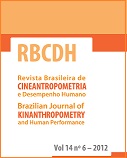Anthropometric profile and abdominal adiposity of school children aged between 6 and 10 years in southern Brazil
DOI:
https://doi.org/10.1590/1980-0037.2012v14n6p636Abstract
The aims of the present study were to assess the association of anthropometric measures with body mass index (BMI) and to verify the presence of abdominal adiposity in school children. This is a cross-sectional study conducted with 4,964 school children between 6 and 10 years of age registered in 345 schools from eight municipalities of the state of Santa Catarina (Brazil). The independent variables used were the following: subscapular (SSF) and triceps skinfold (TSF) thickness, arm circumference (AC), waist circumference (WC), hip circumference (HC), waist-to-hip ratio (WHR), and waist-to-height ratio (WHtR). BMI was used as the dependent variable. Unadjusted and adjusted associations were estimated using linear regression and expressed as a regression coefficient (?). All anthropometric measurements were controlled during adjusted analysis to remain within the p < 0.20 model. Abdominal adiposity was defined as WHtR ? 0.5. The mean BMI was 17.4 kg/m2 (SD = 2.8) in males and 17.2 kg/m2 (SD = 2.8) in females. The mean anthropometric measurements for males and females respectively were as follows: SSF = 7.2 and 8.3mm; TSF = 10.8 and 12.6mm; AC = 20.0 and 20.2cm; WC = 60.1 and 58.5cm; HC = 71.3 and 71.9cm; WHR = 0.84 and 0.81; WHtR = 0.45 and 0.44. All anthropometric measurements were positively associated with BMI in the unadjusted analysis of both sexes. In the adjusted analysis, associations among males were as follows: SSF (? = 0.05), AC (? = 0.17), WC (? = 0.19), and WHtR (? = 30.5). Associations among females were as follows: SSF (? = 0.19), AC (? = 0.17), WC (? = 0.13), WHR (? = -6.2), and WHtR (? = 32.1). The prevalence of abdominal adiposity was 11.9%. It was concluded that the anthropometric indicators SSF, AC, WC, and WHtR had a satisfactory relationship with BMI in school children of both sexes. These measurements could be used, in addition to BMI, to determine total and central adiposity.



